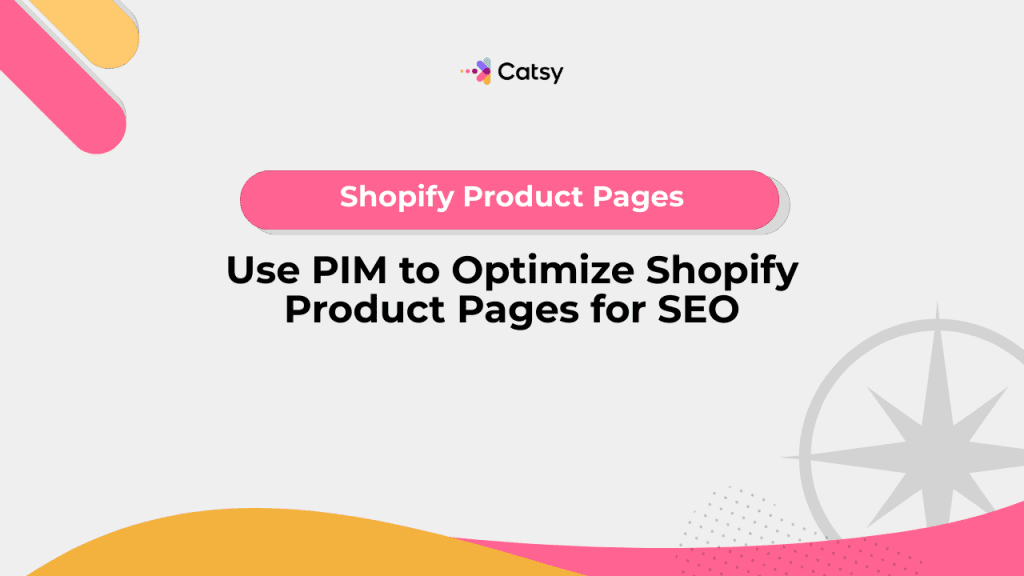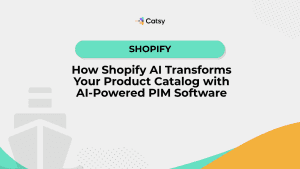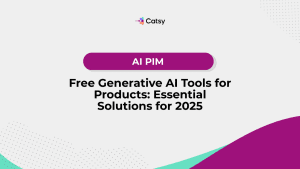Use PIM to Optimize Shopify Product Pages for SEO
Learn how PIM software helps optimize Shopify product pages for SEO. Discover actionable tips to improve product content, metadata, and image alt text using Catsy.

Table of Contents
- Introduction
- Why Shopify Product Page SEO Matters
- How PIM Impacts SEO for Shopify Product Pages
- PIM Features That Directly Improve SEO
- Real-World Use Cases: Shopify SEO Success with PIM
- How Catsy Empowers Shopify SEO with PIM
- How to Use PIM to Build a Search-Optimized Shopify Page (Step-by-Step)
- Conclusion
What You Will Learn
- How product page SEO directly impacts your Shopify store’s organic visibility
- Why PIM tools are essential for ensuring SEO-friendly, structured, and complete product content
- How Catsy’s PIM features like bulk editing, structured metadata, and image alt text improve SEO
- Actionable steps to optimize Shopify product pages using PIM
- Real use cases of brands that improved rankings and conversions with PIM
In this Article
1. Introduction
Every Shopify merchant dreams that their products will appear at the top of Google search. But here’s the problem: your product pages are ships on the e-commerce sea. Only the ones with optimized sails will catch the wind.
Search engine optimization, or SEO, is the fuel behind sustained e-commerce growth. But many merchants overlook the foundations of SEO success: structured, complete, and keyword-rich product content.
Enter PIM (product information management). A modern PIM isn’t just about organizing your SKUs! It’s about optimizing your data to enhance your discoverability and long-term gains.
Let’s dive into how using a Shopify PIM solution like Catsy can help you craft high-ranking Shopify product pages that will drive results.
2. Why Shopify Product Page SEO Matters
a. Organic Discovery Is the Wind in Your Sails
The most cost-effective and scalable channel for e-commerce growth is organic search.
A study by BrightEdge found that 53 percent of website traffic comes from organic search. For e-commerce brands, first page ranking means higher click-through rates and more conversions – without increasing your ad spend.
For Shopify merchants, this means your product pages must do more than just look good; they must be SEO-optimized from the ground up.
b. Where Most Merchants Miss the Mark
Common SEO oversights include:
- Duplicate or thin product descriptions
- Missing image alt tags
- Lack of structured data or schema markup
- Inconsistent metadata like title tags or meta descriptions
- Disorganized or keyword-weak page content
All of these can torpedo your SEO efforts, even if your products are top of the line.
Make Catsy DAM and PIM Software an Extension of Your Team
Book a Free Demo3. How PIM Impacts SEO for Shopify Product Pages
A well-implemented PIM directly supports key SEO areas for Shopify merchants.
a. Structured Data and SEO-Friendly Architecture
Search engines love clean, structured data. A PIM lets you provide just that:
- Standardize content architecture across all product types
- Maintain clean hierarchies and taxonomy for filters and navigation
- Feed structured schema fields to Shopify metafields or headless frameworks
This improves your shop’s crawlability, indexing, and eligibility to display a featured snippet.
b. Optimized Product Descriptions
Keyword-rich, unique descriptions are the cornerstone of on-page SEO. With a PIM:
Unique descriptions that are rich (but not stuffed) with keywords are the cornerstone of on-page SEO. With a PIM, you ensure that there’s no duplicate content across variants or SKUs. SEO templates can use placeholder logic as you scale.
Your product descriptions are enriched dynamically using the product attributes you’ve uploaded.
According to Semrush, well-optimized product descriptions can increase product page visibility by up to 30 percent.
c. Image Optimization with Alt Text
PIM systems can store and assign:
- Image alt text based on your product data
- SEO-friendly filenames
- Versioned media for device responsiveness
This makes your site more accessible and improves your search rankings. Overall, your PIM contributes to improved SEO.
d. URL Slugs, Meta Titles & Meta Descriptions
Catsy and other modern PIMs enable merchants like you to:
- Bulk update URL slugs with keywords
- Auto-generate meta titles and descriptions from attributes
- Preview and optimize metadata per product
Amazing, right? That’s a whole new level of SEO control that Shopify’s native tools can’t match!
4. PIM Features That Directly Improve SEO
a. Bulk Editing & Keyword Implementation
Your PIM offers you a ton of time-saving perks:
- Apply keywords across multiple SKUs
- Insert modifiers (such as “best,” “affordable,” or “eco-friendly”) into descriptions or tags
- Scale SEO consistency across thousands of listings
This is especially useful for large catalogs with similar products throughout.
b. Data Validation for SEO Fields
PIM systems can enforce mandatory fields such as:
- Meta title length
- Minimum description word count
- Alt text requirements
By flagging incomplete SEO data, a PIM like Catsy ensures that gaps that could hurt rankings don’t reach your consumer.
c. Enrichment Workflows for Optimization
Within your own organization, you can assign roles like SEO copywriter, data enrichment specialist, or brand manager.
Each team member can complete their own assigned portion of the SEO process before approval. That information is then syndicated to your outlets to ensure high quality, consistent pages.
d. Managing Tags and Shopify Metafields
PIM makes it easy to manage your tags and meta fields.
Standardize your tags for internal search and collection filters. Populate your meta fields with structured content for tech specs, care instructions, and more. Then, feed this structured content into headless storefronts or rich snippets.
5. Real-World Use Cases: Shopify SEO Success with PIM
a. A Beauty Brand Scaling with Optimized Descriptions
One Shopify-based beauty company used Catsy to:
- Create keyword templates for new product launches
- Auto-fill descriptions using ingredients, benefits, and use cases
- Improve ranking for “organic night cream” and related terms
Result: a 42 percent lift in organic traffic in just six months.
b. A B2B Industrial Supplier Enhancing Discoverability
A business to business supplier needed over 10,000 SKUs to appear in long-tail industrial queries. Using the Catsy PIM, they can standardize tech descriptions across each of their categories. In addition, they implemented structured schema for product specs and bulk edited SEO metadata!
Result: 26 percent more page one rankings and lower bounce rates.
c. A DTC Apparel Store Dominating Long-Tail Keywords
A Shopify merchant used PIM to optimize for specific search terms, like “plus size bamboo yoga pants.” With automated enrichment workflows and alt text templates, their product pages began to rank for more specific, high-conversion terms.
Result: An 18 percent increase in organic conversion rate.
6. How Catsy Empowers Shopify SEO with PIM
a. SEO Templates for Consistency at Scale
Catsy allows you to create SEO title and description formulas as well as placeholder-rich templates. You can also set character limits and preview modes to ensure that each product adheres to SEO best practices … while protecting your brand’s reputation.
b. Integrated Image Management & Alt Text Automation
Catsy’s boasts an integrated DAM (Digital Asset Management) system. That ensures:
- SEO-optimized image naming conventions
- Auto-generated alt text from product attributes
- Asset linking across multiple SKUs
Say goodbye to missed alt tags and low-quality filenames!
c. Real-Time Syndication to Shopify
Once your SEO-rich content is optimized, it’s pushed directly to your Shopify storefronts in real time. There’s no need for copy/paste scenarios or re-uploads. This keeps your product pages ranking … and accurate.
7. How to Use PIM to Build a Search-Optimized Shopify Page (Step-by-Step)
- Centralize Product Data
Begin by importing all your product content into your PIM. Include your SKUs, specs, images, and legacy descriptions. - Audit SEO Fields
Use Catsy’s validation tools to identify missing or weak fields. Common errors occur in meta titles, descriptions, and alt text. - Create Keyword Templates
Build templates using high-value keywords and product attributes to ensure consistency. - Enrich Product Descriptions
Use enrichment workflows to add benefits, features, and structured information. - Add Alt Text and Image Metadata
Assign SEO-friendly alt text based on product attributes and image context. - Optimize Tags and Metafields
Use PIM to manage internal tags, filters, and structured metafields for longtail SEO impact. - Preview & Approve
Preview your content for SEO length limits and quality before pushing your listings live. - Sync to Shopify Use Catsy’s Shopify integration to publish content in real-time, keeping everything updated and consistent.
8. Conclusion
The voyage to SEO dominance on Shopify begins with your product pages. At the heart of every optimized page is structured, complete, and keyword-rich content.
PIM is your best navigational tool. With a platform like Catsy, you have the ability to centralize your product data and enforce SEO best practices. Publish optimized content at scale, right on time.
So tighten the sails, chart your SEO course, and let PIM steer you toward better rankings, higher traffic, and more conversions.
9. Key Takeaways
- SEO-optimized product pages are essential for organic growth on the Shopify platform.
- PIM ensures structured data, complete metadata, and keyword-rich content.
- Features like bulk editing, validation, and templating streamline SEO workflows.
- Catsy’s PIM + DAM integration supports full-page SEO, including alt text and metafields.
- With real-time Shopify sync, Catsy enables faster, consistent publishing of optimized pages.
Want more tips, tutorials, and insights on product content and e-commerce operations?
Stay connected. We post regularly to help brands like yours scale smarter.
Are You Ready To streamline your product content management?

10. Frequently Asked Questions
A PIM system centralizes your product data and enables you to structure, enrich, and optimize content for SEO. That content is then distributed to each of your product pages and channels.
Yes! Catsy helps to optimize your product titles and descriptions, your images, and your metadata. This improves your on-page SEO and boosts your store’s visibility.
Alt text improves the accessibility of your images, and it helps search engines understand the content of those images. This contributes to better image search rankings and, ultimately, better overall SEO.
The tools that “come with” Shopify are basic and manual. PIM helps by providing automation and validation as well as bulk editing. This enables SEO at scale across thousands of SKUs.
Nope. With user-friendly platforms like Catsy, marketers, content teams, and merchandisers can manage SEO workflows without coding.
Subscribe For More Content
Sign up for monthly tips on how to drive revenue with product content.




